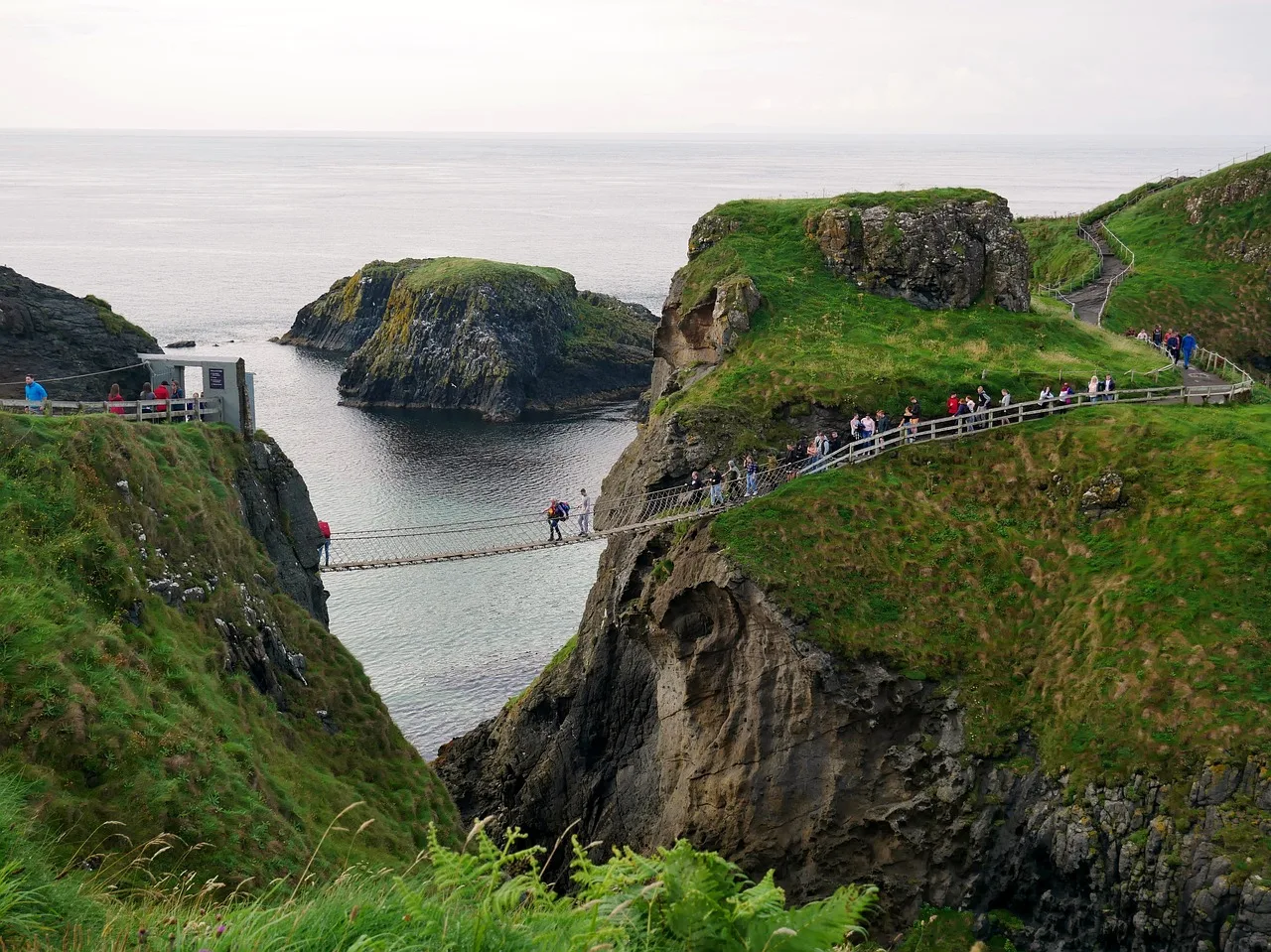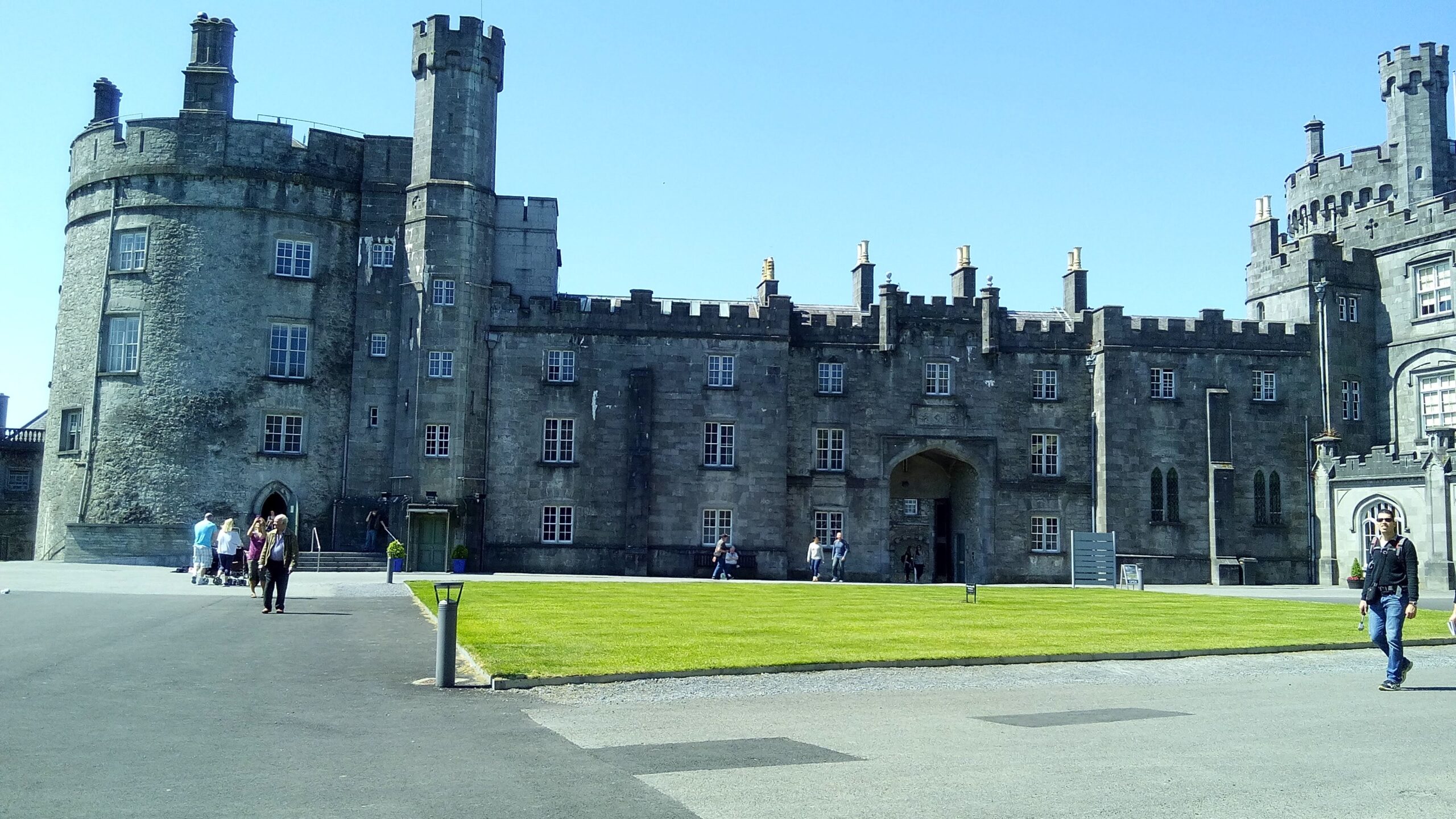
Best of Northern Ireland
Introduction
Northern Ireland is a land of breathtaking beauty and rich history, offering visitors a plethora of remarkable attractions to explore. Accordingly, when it comes to experiencing the best of Northern Ireland, these hidden treasures offer a glimpse into the region’s most captivating aspects.
Among the many gems in this region, the Carrick-a-Rede Rope Bridge, Dark Hedges, Giant’s Causeway and Titanic Museum in Belfast stand out as iconic landmarks. Each site carries its own unique story, captivating visitors with their awe-inspiring natural beauty, intriguing legends, and significant historical importance. Let’s delve deeper into the facts that make them truly remarkable:
1. Carrick-a-Rede Rope Bridge in Northern Ireland

The Carrick-a-Rede Rope Bridge is a famous tourist attraction located in Northern Ireland. It is a suspension bridge that stretches across a 20-meter (66-foot) wide chasm, connecting the mainland to the tiny island of Carrick-a-Rede.
The bridge is situated near Ballintoy in County Antrim, and it offers stunning views of the coastline and the Atlantic Ocean.
The bridge was originally constructed by salmon fishermen in 1755 to access the best fishing spots on the island. Afterwards, it has since been rebuilt and renovated several times to ensure the safety of visitors.
Today, the bridge is managed and maintained by the National Trust, a conservation organization in the United Kingdom. Crossing the Carrick-a-Rede Rope Bridge can be an exhilarating experience for visitors. The bridge sways and moves with the wind, adding to the thrill. Once you reach the other side, you can explore the island, enjoy the beautiful scenery, and take in the panoramic views of the surrounding cliffs and sea.
2. The Dark Hedges in Northern Ireland

In the enchanting countryside of County Antrim, Northern Ireland, lies a captivating stretch of road known as the Dark Hedges. Adorned with a canopy of interlocking beech trees, this mystical pathway has captured the hearts and imaginations of visitors from around the world. With its unique blend of natural beauty, historical significance, and mythical allure, the Dark Hedges stands as a testament to the enduring power of nature’s artistry.
a) Historical Background
The Dark Hedges is believed to have been planted in the 18th century by James Stuart, a local landowner. Intended as a grand entrance to his estate, the beech trees were carefully aligned to create an awe-inspiring avenue. Over the centuries, these trees have thrived, intertwining their branches to form a mesmerizing tunnel of greenery.
b) Natural Beauty and Preservation Efforts
The Dark Hedges exudes an otherworldly charm, especially during the golden hours of sunrise and sunset when the light filters through the canopy, creating an ethereal atmosphere. The interwoven branches and the lush foliage make for a breathtaking sight, drawing photographers, nature enthusiasts, and travelers seeking a unique experience.
Recognizing the significance and fragility of this natural treasure, various conservation efforts have been undertaken. Local authorities have implemented measures to protect the Dark Hedges, including restricting vehicular access and introducing tree preservation plans. These initiatives aim to ensure the longevity of this iconic attraction and preserve its ecological value.
c) Myth and Legend
Beyond its physical beauty, the Dark Hedges is steeped in myth and legend. According to local folklore, the ethereal Grey Lady is said to haunt the hedges, wandering along the road in a flowing gown. Tales of her appearance have sparked countless imaginations and added to the allure of this ancient site.
The Dark Hedges has also gained international recognition due to its appearance in popular culture, notably in the globally acclaimed television series “Game of Thrones.” As a matter of fact, the site served as the backdrop for the King’s Road, a central location in the show. As a result, this exposure further heightened the Dark Hedges’ mystique, attracting a new wave of visitors.
d) Visitor Experience and Tourism Impact
Each year, thousands of tourists flock to the Dark Hedges, mesmerized by its charm and historical significance. Visitors can walk along the road, immersing themselves in the peaceful ambiance and admiring the picturesque scenery. The site has become a pilgrimage for photography enthusiasts and a source of inspiration for artists seeking to capture its magic. The influx of tourists has both positive and negative impacts. On the positive side, tourism has contributed to the local economy, providing business opportunities for nearby establishments such as hotels, restaurants, and souvenir shops. The increased exposure has also helped raise awareness about the conservation efforts required to protect the Dark Hedges.
However, the high volume of visitors has put pressure on the delicate ecosystem surrounding the Dark Hedges. To mitigate this therefore, responsible tourism practices are essential, including maintaining designated paths, respecting the flora and fauna, and adhering to visitor guidelines to minimize human impact.
3. Giants Causeway in Northern Ireland

The Giants Causeway is located on the northern coast of County Antrim in Northern Ireland. It is an extraordinary natural wonder that has captivated visitors for centuries. This is among the best attractions in Northern Ireland. This unique geological formation consists of about 40,000 interlocking basalt columns, resembling a giant staircase that leads into the sea. Designated as a UNESCO World Heritage Site in 1986, the Giants Causeway has not only attracted tourists but also scientists and geologists who marvel at its exceptional beauty and geological significance. In this article, we will explore the fascinating history, geology, legends, and tourism aspects of this magnificent destination.
a) Historical Background
The Giants Causeway’s history dates back over 60 million years when intense volcanic activity shaped the landscape. The formation began with a series of volcanic eruptions, during which molten basalt lava rapidly cooled, resulting in the formation of hexagonal basalt columns. Over time, the cooling and contraction of the lava created the iconic honeycomb-like pattern that we see today.
The name “Giants Causeway” stems from the ancient legend associated with its formation. According to local folklore, an Irish giant named Fionn mac Cumhaill (Finn McCool) built the causeway as a bridge to confront his rival, the Scottish giant Benandonner. As the story goes, Fionn defeated Benandonner by disguising himself as a baby, convincing Benandonner that if the baby was so large, Fionn himself must be truly colossal. Fleeing in terror, Benandonner destroyed the causeway behind him, leaving only what we now know as the Giants Causeway.
b) Geological Marvel
The geological significance of the Giants Causeway lies in its exceptional columnar jointing, which has fascinated scientists for centuries. The columns, predominantly hexagonal in shape, are a result of the slow cooling of basalt lava flows, leading to the contraction and cracking of the rock. While hexagonal columns are the most common, other polygonal shapes, such as pentagons and heptagons, can also be found.
The unique rock formations at the Giants Causeway are not limited to the columns alone. Visitors can also witness various geological features like the Giant’s Boot, the Organ, the Chimney Stacks, and the Amphitheatre. These formations offer an incredible display of nature’s artistry and provide valuable insights into the Earth’s geological processes. In addition to its striking columns, the Giants Causeway is also home to diverse plant and animal species. The rugged coastline, with its rock pools and crevices, provides a habitat for various seaweeds, mollusks, and crustaceans. Bird species, including fulmars, guillemots, and razorbills, nest on the cliffs, making it a paradise for birdwatchers.
c) Legends and Mythology
Legends and folklore have always surrounded the Giants Causeway, adding an air of mystery and enchantment to this natural wonder. The tales of giants and their epic battles have been passed down through generations, becoming an integral part of the region’s cultural identity. The legend of Fionn mac Cumhaill and Benandonner is just one of the many stories associated with the Giants Causeway. According to another popular legend, the columns were once stepping stones used by an Irish giant named Finn to cross over to Scotland. There, he built a similar causeway to challenge Benandonner. However, upon seeing the immense size of Benandonner, Finn fled back to Ireland, allowing his wife, Oonagh, to disguise him as a baby and fool the Scottish giant.
These legends not only provide a rich narrative but also offer insights into the historical and cultural heritage of the region. The Giants Causeway has become a symbol of Northern Ireland, representing its mythology and connecting people to their ancestral roots.
d) Tourism and Conservation
The Giants Causeway has been a popular tourist destination for centuries, attracting visitors from around the world. In recent years, it has experienced a significant increase in tourism, partly due to its inclusion in popular culture, such as being featured in movies and TV shows.
To cater to the growing number of visitors, the National Trust, which manages the site, has implemented measures to ensure a sustainable and responsible tourism experience. Visitors can explore the area by following well-maintained trails and guided tours, which provide both educational and entertaining experiences. The visitor center offers interactive displays, exhibitions, and audio guides, enhancing the understanding of the site’s geological and cultural significance.
Preserving the Giants Causeway and its surrounding environment is of utmost importance. The National Trust actively engages in conservation efforts, including managing footfall, preventing erosion, and protecting the unique ecosystem of the area. Visitors are encouraged to respect the site, follow designated pathways, and avoid damaging the delicate rock formations.
4. Titanic Museum Belfast

Nestled in the heart of Belfast, the Titanic Museum stands as a testament to the remarkable history of the RMS Titanic, the ill-fated ocean liner that tragically sank on its maiden voyage in 1912. The Titanic Museum Belfast is an extraordinary attraction that captivates visitors with its immersive exhibitions, interactive displays, and poignant stories. The museum is an absolute must-visit for anyone intrigued by the Titanic’s legacy and the era in which it sailed.
a) Historical Significance
The Titanic Museum Belfast offers a unique opportunity to step back in time and explore one of the most iconic maritime disasters in history. The museum is situated in the original Harland and Wolff shipyard where the Titanic was built, infusing the space with an unparalleled sense of authenticity. Visitors can witness the birthplace of the Titanic and gain a profound understanding of the historical, social, and cultural context surrounding its construction.
b) Interactive Exhibits
One of the standout features of the Titanic Museum Belfast is its interactive exhibits, which allow visitors to engage with the story of the Titanic in a truly immersive manner. From full-scale reconstructions of the ship’s decks and cabins to hands-on experiences, visitors can step into the shoes of the passengers and crew, getting a taste of life on board this opulent vessel. The museum’s interactive nature appeals to visitors of all ages, making it an excellent choice for families, history enthusiasts, and curious minds alike.
c) Unveiling the Untold Stories
Beyond its grandeur and architectural marvel, the Titanic’s legacy lies in the untold stories of its passengers and crew. The museum sheds light on the personal narratives of those aboard, from the luxurious first-class passengers to the hardworking crew members in steerage.
Through a diverse range of exhibits, including personal belongings, letters, and testimonies, the museum humanizes the tragic event, honoring the lives lost and providing a deeper understanding of the human experience associated with the Titanic.
d) The Shipyard Experience
The Titanic Museum Belfast isn’t just about the Titanic itself. It also offers a comprehensive insight into the bustling shipyard that brought this magnificent vessel to life. Visitors can explore the shipyard’s giant yellow cranes, walk along the slipways, and marvel at the sheer scale of the Titanic’s construction.
This aspect of the museum allows visitors to appreciate the craftsmanship and innovation that went into building such a colossal ship, highlighting Belfast’s rich industrial heritage.
e) Titanic Artefacts and Collections
The museum houses an impressive collection of over 400 original artifacts recovered from the Titanic wreckage, many of which are displayed for public viewing. These artifacts range from everyday objects like cutlery, china, and clothing to poignant personal items that belonged to the passengers. Seeing these artifacts up close offers a tangible connection to the past, immersing visitors in the world of the Titanic and its passengers.
f) Architectural Splendor
The architectural design of the Titanic Museum Belfast is an attraction in itself. The building’s structure mirrors the shape of the Titanic’s bow and features a striking exterior clad in reflective aluminum panels. The interior, designed to resemble the grand staircase of the Titanic, exudes elegance and opulence. The meticulous attention to detail pays homage to the ship’s luxurious design, further enhancing the museum’s immersive atmosphere.
g) Educational Opportunities
The Titanic Museum Belfast provides invaluable educational opportunities for students and teachers alike. The museum offers tailored educational programs, workshops, and guided tours, making it an excellent destination for school trips and educational outings. Through engaging exhibits and informative displays, students can learn about various subjects, including maritime history, engineering, social classes, and even the science of deep-sea exploration.
h) Unparalleled Visitor Experience
From the moment visitors step through the doors of the Titanic Museum Belfast, they are transported to a bygone era. The museum’s captivating storytelling, state-of-the-art technology, and multimedia presentations create a multisensory experience that is both informative and emotionally engaging. The museum’s dedication to providing a world-class visitor experience, ensures that every guest leaves with a profound appreciation for the Titanic’s legacy.
5. Marble Arch Caves
Subterranean Wonder Delve into the mysterious world beneath the surface at Marble Arch Caves. Located in County Fermanagh, this enchanting network of caves and underground rivers offers a captivating underground experience. Explore awe-inspiring chambers, stunning stalactites, and learn about the geology and legends that surround this hidden wonder.
6. Rathlin Island
A Wildlife Haven Escape to Rathlin Island, an oasis of nature and wildlife off the Antrim coast. This remote island is home to diverse bird species, including puffins and razorbills. Take a stroll along the rugged cliffs, visit the lighthouse, and embrace the tranquility of this untouched gem.
7. Cushendun Caves
These captivating caves, formed by intense wave action, hold historical significance. They were used as a filming location for “Game of Thrones.” Their mysterious atmosphere adds to their allure.
8. Mount Stewart

This world-renowned garden estate features an impressive collection of plants from around the globe. It was the former residence of the Stewart family and showcases stunning neo-classical architecture. The gardens are meticulously designed and boast a wide array of rare and exotic species.
9. Navan Fort
Known as Emain Macha in Irish mythology, Navan Fort was the legendary seat of the ancient kings of Ulster. Archaeological excavations have revealed evidence of human settlement dating back over 7,000 years. It remains an important historical and cultural site in Northern Ireland.
10. The Mourne Wall
Constructed between 1904 and 1922, the Mourne Wall is an impressive feat of engineering. It spans 15 summits across the Mourne Mountains, acting as a catchment area boundary for the Silent Valley Reservoir. Its purpose was to keep livestock out of the water supply.
Conclusion
By exploring these hidden treasures, visitors can truly experience the best of Northern Ireland. From the mythical landscapes to the rich history and natural wonders, each site offers a unique and unforgettable experience. So add it to your bucket list to come and experience the best Northern Ireland has to offer and create memories that will last a lifetime.




